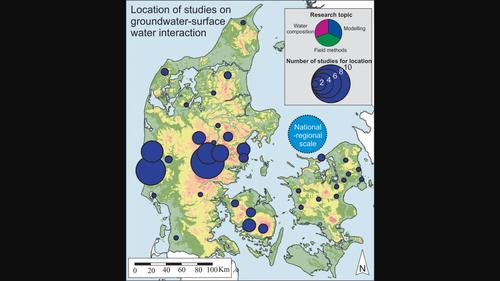Groundwater–surface water interaction in Denmark
IF 5.8
1区 地球科学
Q1 ENVIRONMENTAL SCIENCES
引用次数: 0
Abstract
The study of groundwater–surface water interaction has attracted growing interest among researchers in recent years due to its wide range of implications from the perspectives of water management, ecology and contamination. Many of the studies shed light on conditions on a local scale only, without exploring a regional angle. To provide a broad and historical overview of groundwater–surface water interaction, a review of research carried out in Denmark was undertaken due to the high density of studies conducted in the country. The extent to which this topic has been investigated is related to Denmark's physiography and climate, the presence of numerous streams and lakes combined with shallow groundwater, and historical, funding, and administrative decisions. Study topics comprise groundwater detection techniques, numerical modeling, and contaminant issues including nutrients, ranging from point studies all the way to studies at national scale. The increase in studies in recent decades corresponds with the need to maintain the good status of groundwater‐dependent ecosystems and protect groundwater resources. This review of three decades of research revealed that problems such as the difference in scales between numerical models and field observations, interdisciplinary research integrating hydrological and biological methods, and the effect of local processes in regional systems remain persistent challenges. Technical progress in the use of unmanned aerial vehicles, distributed temperature sensing, and new cost‐effective methods for detecting groundwater discharge as well as the increasing computing capacity of numerical models emerge as opportunities for dealing with complex natural systems that are subject to modifications in future triggered by climate change.

丹麦地下水与地表水的相互作用
地下水-地表水相互作用的研究从水管理、生态学和污染等方面具有广泛的意义,近年来引起了研究人员的广泛关注。许多研究只阐明了局部范围内的情况,而没有从区域角度进行探索。为了提供地下水-地表水相互作用的广泛和历史概况,由于在丹麦进行的研究密度高,因此对在丹麦进行的研究进行了审查。该主题的研究程度与丹麦的地理和气候、众多河流和湖泊与浅层地下水的存在以及历史、资金和行政决定有关。研究主题包括地下水探测技术、数值模拟和污染物问题,包括营养物质,范围从点研究一直到国家尺度的研究。近几十年来研究的增加与维持地下水依赖生态系统的良好状态和保护地下水资源的需要相一致。对30年研究的回顾表明,诸如数值模式与实地观测之间的尺度差异、水文和生物方法相结合的跨学科研究以及区域系统中局部过程的影响等问题仍然是持续的挑战。无人驾驶飞行器的技术进步、分布式温度传感、探测地下水排放的新成本效益方法,以及数值模型计算能力的提高,都为处理复杂的自然系统提供了机会,这些系统在未来可能受到气候变化的影响。
本文章由计算机程序翻译,如有差异,请以英文原文为准。
求助全文
约1分钟内获得全文
求助全文
来源期刊

Wiley Interdisciplinary Reviews: Water
Environmental Science-Ecology
CiteScore
16.60
自引率
3.70%
发文量
56
期刊介绍:
The WIREs series is truly unique, blending the best aspects of encyclopedic reference works and review journals into a dynamic online format. These remarkable resources foster a research culture that transcends disciplinary boundaries, all while upholding the utmost scientific and presentation excellence. However, they go beyond traditional publications and are, in essence, ever-evolving databases of the latest cutting-edge reviews.
 求助内容:
求助内容: 应助结果提醒方式:
应助结果提醒方式:


